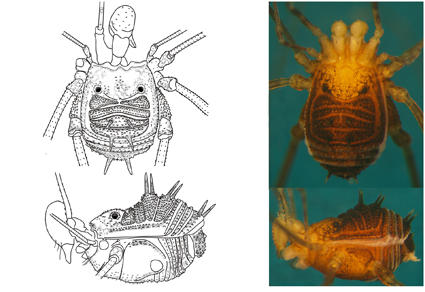Abstract
Caribbiantes cubanus Šilhavý, 1973, type species of genus Caribbiantes Šilhavý, 1973, is redescribed based on abundant material from the type locality, providing new data on its morphological variability and penis morphology. Two new species of Caribbiantes are described, C. obtusus sp. nov. and C. barbai sp. nov., based on additional specimens from central and eastern Cuba, for which we give information on their geographical distribution, intraspecific variability and habitat. A new diagnosis for Caribbiantes and updated geographic distributions of the included species are provided. The sexually dimorphic glandular structures on the metatarsus III of males for all Caribbiantes species are described. Male dimorphism, most evident in the robustness of the chelicerae, is reported for the studied species. The male genitalia patterns of Antillean stenostygnines species are described. The phylogenetic affinity of Antillean stenostygnines with Stenostygnus Simon, 1879, a genus from the north of South America, is discussed based on some morphological traits.
References
- Acosta, L.E., Pérez-González, A. & Tourinho, A.L. (2007) Methods and techniques of study. In: Pinto-da-Rocha, R., Machado, G. & Giribet, G. (Eds.), Harvestmen: the biology of Opiliones. Harvard University Press, Cambridge, pp. 494–505.
- Alegre Barroso, A. & Armas, L.F. (2012) A new species of Heterolacurbs (Opiliones: Biantidae: Stenostygninae) from Puerto Rico. Journal of Arachnology, 40, 291–295. https://doi.org/10.1636/Ha11-73.1
- Alegre, A., Gainett, G., López-Iborra, G. & Giribet, G. (2019) Two new species of Manahunca, redescription of its type species, current conservation status of the genus and a survey of male glands in Stenostygninae (Opiliones: Laniatores: Biantidae). Zootaxa, 4686 (1), 083–111. https://doi.org/10.11646/zootaxa.4686.1.4
- Avram, S. (1977) Recherches sur les opilionides de Cuba. III. Genres et espèces nouveaux de Caribbiantinae (Biantidae: Gonyleptomorphi). Resultats des Expéditions Biospéologiques. Cubano-Roumaines à Cuba, 2, 123–136.
- Ferreira, C.P. & Kury, A.B. (2010) A review of Roquettea, with description of three new Brazilian species and notes on Gryne (Opiliones, Cosmetidae, Discosomaticinae). Zoological Science, 27, 697–708. https://doi.org/10.2108/zsj.27.697
- Kury, A.B. (1989) Notes on Mitobatinae III: A remarkable new Brazilian species of Mitobates Sundevall, 1833 (Opiliones, Laniatores, Gonyleptidae). Boletim do Museu Nacional, New Series Zoologia, 328, 1–12.
- Kury, A.B. & Pérez-González, A. (2007) Biantidae Thorell, 1889. In: Pinto-da-Rocha, R., Machado, G. & Giribet, G. (Eds.), Harvestmen: the biology of Opiliones. Harvard University Press, Cambridge, pp. 176–179.
- Mamani, C.V., Porto, W., Iglesias, P.P. & Pérez-González, A. (2021) Two new species of Stenostygnus from South America (Opiliones: Biantidae: Stenostygninae). Zootaxa, 4984 (1), 182–202. https://doi.org/10.11646/zootaxa.4984.1.15
- Pinto-da-Rocha, R. (1995) Redescription of Stenostygnus pusio Simon and synonymy of Caribbiantinae with Stenostygninae (Opiliones: Laniatores, Biantidae). Journal of Arachnology, 23, 194–198.
- Pérez-González, A. & Alegre, A. (2009) On the enigmatic Heterolacurbs ovalis Roewer, 1912 (Opiliones, Laniatores, Biantidae). Zootaxa, 2269 (1), 65–67. https://doi.org/10.11646/zootaxa.2269.1.5
- Pérez-González, A., Sharma, P.P. & Proud, D.N. (2016) Morphological tricks and blessed genitalia: rectifying the family placement of Fijicolana tuberculata (Opiliones: Laniatores: Zalmoxidae). Zootaxa, 4061 (3), 253–260. https://doi.org/10.11646/zootaxa.4061.3.3
- Roewer, C.F. (1912) Die Familien der Assamiden und Phalangodiden der Opiliones-Laniatores. (= Assamiden, Dampetriden, Phalangodiden, Epedaniden, Biantiden, Zalmoxiden, Samoiden, Palpipediden anderer Autoren). Archiv für Naturgeschichte, 78A (3), 1–242.
- Šilhavý, V. (1973) Two new systematic groups of gonyleptomorphid phalangids from the Antillean-Caribbean Region. Agoristenidae fam. n. and Caribbiantinae subfam. n. Vestník Ceskoslovenské Spolecnosti Zoologické, 37 (2), 110–143.
- Thorell, T.T.T. (1889) Aracnidi Artrogastri Birmani raccolti da L. Fea nel 1885–1887. In: Viaggio di Leonardo Fea in Birmania e regione vicine. XXI. Annali del Museo Civico di Storia Naturale di Genova, 7 (3), 521–729. https://doi.org/10.5962/bhl.title.10400
- Wolff, J.O., Schönhofer, A.L., Martens, J., Wijnhoven, H., Taylor, C.K. & Gorb, S.N. (2016) The evolution of pedipalps and glandular hairs as predatory devices in harvestmen (Arachnida, Opiliones). Zoological Journal of the Linnean Society, 177 (3), 558–601. https://doi.org/10.1111/zoj.12375


